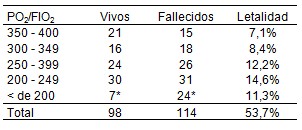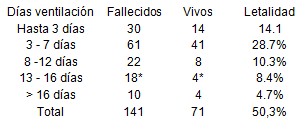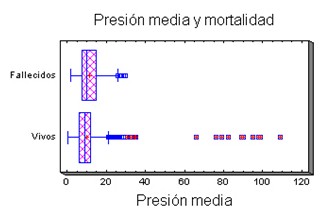Al valorar la relación existente entre el índice PO2/FIO2 como parámetro de oxigenación (tabla 5) encontramos que la mortalidad se incrementó de manera significativa en el subgrupo de pacientes que presentaba un índice de PO2/FIO2 promedio menor de 200, lo cual se traduce como un compromiso importante de la función pulmonar y/o SDRA, siendo esperado que tuvieran resultados finales desfavorables, hecho este señalado con exhaustividad en la literatura consultada. Llama la atención en esta tabla que la mortalidad fue mayor en el grupo de índice PO2/FIO2 entre 200 a 249, lo cual pudiera estar en relación tanto con las limitaciones de la muestrea como por la patología subyacente que motivo el uso de la ventilación mecánica.
Tabla 5. Mortalidad según PO2/FIO2. Fuente: historias clínicas. n = 212. X2 = 5,345 significativo.

En relación con los días de ventilación (tabla 6) podemos ver que la mortalidad se incrementó tal y como era de esperar en el subgrupo de pacientes con soporte ventilatorio entre 13 y 16 días.
Tabla 6. Días de ventilación y mortalidad. Fuente: historias clínicas. n = 212. X2 = 4,958 significativo

En la tabla 7 podemos apreciar un incremento estadísticamente significativo en la mortalidad en el subgrupo de pacientes con presión arterial media menor de 90 mmHg, hecho este que coincide con lo reportado por otros autores y que se explica por el efecto deletéreo que representa la afectación hemodinámica en los pacientes.
Tabla 7. Variables hemodinámicas y mortalidad. Fuente: historias clínicas. n = 212. X2 = 5,063.significativo.

El gráfico 1 muestra que a pesar de no registrar valores de presión media elevados en la vía aérea por el uso ya señalado de la ventilación protectora en nuestro servicio, esta fue estadísticamente significativa más elevada en el grupo de pacientes que fallecieron, lo cual está en contradicción con lo referido por otros autores que el daño pulmonar se produce cuando los valores de presión sobrepasan los 30 cm de agua. esto pudiera estar en relación con el sesgo muestral y con la patología de base, a pesar de lo cual pensamos necesitaríamos de estudios posteriores para valorar este hallazgo
Gráfico 1. Presión media y mortalidad. Fuente: historias clínicas. n = 212. W = 659962,0 P-Valor = 0,0 significativo.

Referencias bibliográficas:
1. Parker J, Hernandez L, Peevy K. Mechanisms of ventilator-induced lung injury.CritCareMed.1993;21:131-43.
2. Esteban A, Fernández-Segoviano P, Gordo F, Aramburu J, Alia I, Martín A, et al. Correlation among clinical and post-mortem diagnosis of ARDS. Am J RespirCritCareMed.1996;159:718A.
3. Slutsky A, Tremblay L. Multiple system organ failure: is mechanical ventilation a contributing factor AmJRespirCritCareMed.1998; 157:1721-5.
4. Offner P, Moore E. Lung injury severity scoring in the era of lung protective mechanicalventilation:thePaO2/FiO2ratio.JTrauma.2003;55:285-9.
5. Esteban A, Anzueto A, Frutos F, Alia I, Brochard L, Stewart T, et al. Characteristics and outcomes in adult patients receiving mechanical ventilation. A 28-day international study. JAMA. 2002; 287:345-55.
6. The Acute Respiratory Distress Syndrome Network. Ventilation with lower tidal volumes as compared with traditional tidal volumes for acute lung injury and the acute respiratory distress syndrome. N Engl J Med. 2000; 342:1301-8.
7. The Acute Respiratory Distress Syndrome Network. Higher versus lower positive end-expiratory pressures in patients with the acute respiratory distress syndrome. N Engl J Med. 2004; 351: 327-36.
8. Lionett V, Recchia F, Rainier M. Overview of ventilator-induced lung injury mechanisms. Current Opinion in Critical Care. 2005; 11:82-6.
9. Petrucci N, Iacovelli W. Ventilation with smaller tidal volumes: a quantitative systematic review of randomized controlled trials. Anesth Analg.2004; 99:193-200.
10. Amato MB, Barbas CS, Medeiros DM, Magaldi RB, Schettino GP, Lorenzi-Filho G, et al. Effect of a protective-ventilation strategy on mortality in the acute respiratory distress syndrome. N Engl J Med. 1998 , 338, 347 -54.
11. Stewart TE, Meade MO, Cook DJ, Granton JT, Hodder RV, Lapinsky SE, et al. Evaluation of a ventilation strategy to prevent barotrauma in patients at high risk for acute respiratory distress syndrome. Pressure- and Volume-Limited Ventilation Strategy Group. N Engl J Med. 1998; 338:355-61.
12. Bernard GR, Artigas A, Brigham KL, Carlet J, Falke K, Hudson L, et al. The American-European Consensus Conference on ARDS. Definitions, mechanisms, relevant outcomes, and clinical trial coordination. Am J Respir Crit Care Med. 1994; 149: 818-24
13. Katzenstein AL, Bloor CM, Leibow AA. Diffuse alveolar damage--the role of oxygen, shock, and related factors. A review. Am J Pathol. 1976; 85:209-28.
14. Marini JJ, Gattinoni L. Ventilatory management of acute respiratory distress syndrome: a consensus of two. Crit Care Med. 2004; 32:250-5.
15.Ochs M, Nyengaard JR, Jung A, Knudsen L, Voigt M, Wahlers T, et al. The number of alveoli in the human lung. Am J Respir Crit Care Med. 2004,
169:120-4.
16. Gattinoni L, Pesenti A, Avalli L, Rossi F, Bombino M. Pressure-volume curve of total respiratory system in acute respiratory failure. Computed tomographic scan study. Am Rev Respir Dis. 1987; 136:730-6.
17. Gattinoni L, D'Andrea L, Pelosi P, Vitale G, Pesenti A, Fumagalli R. Regional effects and mechanism of positive end-expiratory pressure in early adult respiratory distress syndrome. JAMA. 1993; 269:2122-7.
18. Gattinoni L, Eleonora C, Caironi P. Monitoring of pulmonary mechanics in acute respiratory distress syndrome to titrate therapy. Curr Opin Crit Care. 2005; 11:252-8.
19. Pierson D.J. Alveolar rupture during mechanical ventilation: role of PEEP,
Peak airway pressure and distending volume. Respir. Care. 1988; 33: 472-486.
20. Parker J.C., Hernandez L.A., Peevy K.J. Mechanisms of ventilator induced Lung injury. Crit. Care Med. 1993; 21: 131-143.
21. Gammon R.B., Shin M.S., Groves R.H., et al. Clinical risk factors of Pulmonary barotrauma: a multivariate analysis. Am. J. Respir. Crit. Care Med. 1995; 152: 1235-1240.
22. Slutsky A.S. Consensus Conference on mechanical ventilation. Intens. Care Med. 1994; 20: 64-79.
23. Sessler C.N. Mechanical ventilation of patients with acute lung injury. Crit.Care Med. 1998; 14 (4): 707-729.
24. Greenfield L.J., Ebert P.A., Benson D.W. Effect of positive pressure Ventilation on surface tension properties of lung extracts. Anesthesiology 1964;